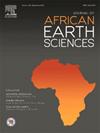The Shadli metavolcanic belt in the south Eastern Desert of Egypt: A late Tonian-Cryogenian hotspot track in the northern Arabian-Nubian Shield
IF 2.2
4区 地球科学
Q2 GEOSCIENCES, MULTIDISCIPLINARY
引用次数: 0
Abstract
The Shadli Metavolcanic Belt (SMB) trends ∼120 km E-W and 20–40 km wide in SE Egypt; its origin (rift, plume, arc) and age (∼695–750 Ma) are controversial. Intermediate and felsic samples from two areas in the eastern belt were studied for U-Pb zircon ages and oxygen isotopes by ion probe and Hf isotopes by LA-ICP-MS and for whole rock Sr and Nd isotopic compositions. Three (Late Tonian) concordia ages of 738.4 ± 3.4, 739.2 ± 3.7 and 727.2 ± 6.5 Ma were determined. Oxygen isotopes range ∼4.4–4.6 ‰, significantly lower than the nominal mantle zircon average of 5.3 ‰, indicating the involvement of a hydrothermally altered crust. Hf isotopic compositions yield εHf(t) with a mean of +13.8; whole-rock initial 87Sr/86Sr isotopic compositions average 0.7027 and εNd (739 Ma) averages +5.1; these indicate a depleted mantle source with no participation of old continental crust. Integrating our new results with those of other studies reveals a westward decrease in age for the eastern SMB at ∼1 km/Ma. This is unexpected for a volcanic arc and is best explained by eastward motion of the Arabian-Nubian Shield over a fixed mantle hotspot. Trace element compositions suggest both OIB-like and arc-like mantle sources for basalts and arc-like sources for differentiated lavas. These observations are best explained by entrainment of older subduction-modified lithospheric mantle in a rising mantle plume followed by partial melting of a mixed mantle source at the top of the base of the crust to generate basalts and interaction of mafic magmas with >750 Ma juvenile arc to generate fractionated lavas with arc-like trace element characteristics. The results of this study should motivate research to determine ages and isotopic compositions of the western half of the SMB, study relationship of SMB to the batholith flanking it on the north, study a N-S transect across the SMB and revise SMB mineral exploration strategies.
埃及东南部沙漠Shadli变火山带:阿拉伯-努比亚地盾北部晚托尼-低温期热点轨迹
Shadli变火山带(SMB)在埃及东南部走向东西向~ 120 km,宽20 ~ 40 km;它的起源(裂谷、羽流、弧)和年龄(~ 695-750 Ma)是有争议的。利用离子探针和LA-ICP-MS分别对东带2个地区的中长英质样品进行了U-Pb锆石年龄、氧同位素和Hf同位素的研究,并对整个岩石的Sr和Nd同位素组成进行了研究。测定了3个(晚托尼亚)协和年龄,分别为738.4±3.4、739.2±3.7和727.2±6.5 Ma。氧同位素变化范围为~ 4.4 ~ 4.6‰,明显低于名义地幔锆石平均值5.3‰,表明地壳参与了热液蚀变。Hf同位素组成的εHf(t)平均值为+13.8;全岩初始87Sr/86Sr同位素组成平均值为0.7027,εNd (739 Ma)平均值为+5.1;这表明一个枯竭的地幔源,没有旧大陆地壳的参与。将我们的新结果与其他研究结果相结合,发现东部SMB的年龄在1 km/Ma时向西减小。这对于火山弧来说是出乎意料的,最好的解释是阿拉伯-努比亚地盾在一个固定的地幔热点上向东运动。微量元素组成表明玄武岩的幔源为obb型和弧型,而分异熔岩的幔源为弧型。这些观测结果最好的解释是,在上升的地幔柱中,较老的俯冲修正岩石圈地幔被夹带,随后在地壳底部顶部混合地幔源的部分熔融产生玄武岩,以及基性岩浆与>;750 Ma幼弧相互作用产生具有弧状微量元素特征的分块熔岩。这一研究结果将有助于进一步确定中小板构造西半部的年龄和同位素组成,研究中小板构造与北侧基岩的关系,研究横跨中小板构造的南北向样带,并修订中小板构造的找矿策略。
本文章由计算机程序翻译,如有差异,请以英文原文为准。
求助全文
约1分钟内获得全文
求助全文
来源期刊

Journal of African Earth Sciences
地学-地球科学综合
CiteScore
4.70
自引率
4.30%
发文量
240
审稿时长
12 months
期刊介绍:
The Journal of African Earth Sciences sees itself as the prime geological journal for all aspects of the Earth Sciences about the African plate. Papers dealing with peripheral areas are welcome if they demonstrate a tight link with Africa.
The Journal publishes high quality, peer-reviewed scientific papers. It is devoted primarily to research papers but short communications relating to new developments of broad interest, reviews and book reviews will also be considered. Papers must have international appeal and should present work of more regional than local significance and dealing with well identified and justified scientific questions. Specialised technical papers, analytical or exploration reports must be avoided. Papers on applied geology should preferably be linked to such core disciplines and must be addressed to a more general geoscientific audience.
 求助内容:
求助内容: 应助结果提醒方式:
应助结果提醒方式:


